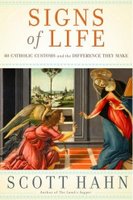
I’ve been a Catholic for almost a quarter-century, and still I marvel at the richness of the life we share. We’re borne along in this life by a sacred tradition, a primal element of customs of prayer. We pray with our hearts and minds, our souls and bodies. We pray with our posture and gestures, our words and silence, with water and wool, with bread and wine.
I love the Catholic life, and I’ve long wanted to write a book that would celebrate the things that make it so full and rich.
Now I have! And I’m very excited to let you know. It’s called Signs of Life: 40 Catholic Customs and Their Biblical Roots.
If you’ve read my books, you know that I practice a method I learned from the Church Fathers. It’s called mystagogy — or, guidance in the mysteries. Mystagogy enables believers to see beyond the Church’s signs and rituals, to the things signified — to see beyond the symbols and glimpse the divine mysteries that will one day be fully visible to us in heaven (1 John 3:2).
In Signs of Life, I apply the method to the Church’s sacraments, of course — but also to its most beloved customs and sacramentals. A sacramental is any object set apart and blessed by the Church to increase our devotion — holy water, scapulars, medals, icons, the Sign of the Cross, relics, incense, votive candles, feast days and holy seasons. I also touch upon basic practices of prayer, such as reverence for the tabernacle, devotion to the angels, making a morning offering, saying a rosary, care for the dying, and prayers for the dead. Those are just a few of the topics covered in the book’s forty chapters. They’re forty explorations, really, of the Church’s ancient interpretation of the Bible.
For as I studied, and as I grew in the practice of these devotions, and as I spoke with other Catholics, I learned that the biblical roots of these customs are deep indeed. They are evidence of the close attention the Church has paid, over the course of centuries, to Scripture. Ordinary people, desiring to be more and more faithful to God’s Word, found old-fashioned ways to be new. From the Bible, they learned to sanctify water, make the Sign of the Cross, and let their prayers rise like incense. From ancient times, Christians expressed their love in devotions that are biblical in form, content, and spirit.
I think you’ll thrill at this book’s discoveries, as I did. Did you know that the custom of the brown scapular was inspired not only by the doctrine of the New Testament, but the prophecies of the Old as well? Learning the back story changed my experience of wearing the scapular, and made it a more powerful prayer.
As Catholics, we know that matter matters. Jesus could have cured the blind man with a simple nod or a word. But He didn’t. He made a paste of mud and spit, and then He sent him off to wash in a nearby pool.
He did that not for His own sake, but for ours. God knows human nature, and so he knows that we often need to do something, and not just stand there, and so the Catholic life is filled with glorious things to do.
When you and I do these things, we pray in the Spirit. When I pray this way, I pray for you. As always, I invite you to join me in prayer; and when you do, please remember the St. Paul Center.